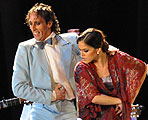July 18th to August 31st
JARDINES DEL GENERALIFE. GRANADA
Text & photos: Antonio Conde
Elenco artístico
Rubén Olmo
Rubén Olmo. Soloists: Patricia Guerrero, Eduardo Leal Corps de ballet: Sara Vázquez, Ana Agraz, Marta Arias, Mónica Iglesias, Maise Márquez, Juan Carlos Cardoso, Ángel Fariña Fernando Jiménez, Álvaro Paños Singers: Fabiola, Manuel “El Zambullo”, Olivia Molina. Guitar: Manuel de la Luz, Daniel Jurado. Percussion: David “Chupete”. Piano: Cristian de Moret. Sax-flute: Ignacio Vidaechea
Some changes have been made this year to honor the memory of García Lorca with a show presented each year in the gardens of the Generalife. Rubén Olmo, director and choreographer of the Ballet Andaluz de Flamenco, was in charge of organizing the script into a two-part show: on the one hand, “Metáfora”, a work which has been circulating for several months, and on the other, “Llanto por la Muerte de Ignacio Sánchez Mejías”. Times are achangin’ for the Compañía Andaluza de Flamenco. The director’s youth is an attractive feature and quite an adventure considering past problems that need to be resolved.
The script that was presented and will continue throughout the summer at the Generalife, is a double program. A collection of ideas and of ways of understanding flamenco from the prism of Lorca and from the philosophical point of view of Nietzsche. When you think about it, if we were to apply philosophical perspectives to Lorca’s work, there would be no end to what would come out; but not everything goes.
The choice of a German philosopher is novel, at least for working with Lorca. Putting aside theories regarding the Granada poet, a new path is opened which might give meaning to “Metáfora”.
The first part is a flamenco suite in a historical setting with flashes that transport us to the past. Alegrías danced by Patricia Guerrero pays homage to the so-called Seville school, particularly to Matilde Coral, making Patricia the unquestionable star of the show. Guerrero invaded the ample stage with her bata de cola, and gave a very high-quality performance. Despite her youth, the Granada dancer has everything it takes to become a major star before long. Her style is very personal, her technique brilliant. It makes no difference whether she does jaleos or Granada tangos, her versatility is admirable, she is a true chameleon.
There were some noteworthy changes. Guest artists Antonio Canales and Pastora Galván were not announced for this weekend, so the taranto duet was done by Carlos Cardoso and Marta Arias.
The first part was ended with bulerías with Patricia Guerrero the main dancer, and tangos by the group. This initial part was brief, having been shortened from the original version, and seemed like little more than something tacked on to temporarily complement the second part.
After an intermission that could easily have been omitted, the poem that Lorca dedicated to the bullfighter Sánchez Mejías becomes the central theme. A story of secret love, an intimate vision of personal relationships between intellectuals and bullfighters in Seville society of the era, with the flamenco fiestas of Pino Montano. All the right ingredients for success. But the transitions and story line didn’t quite come off. In bulerías, with the cante of Fabiola, a large group of interpreters represented a fiesta at the bullfighter’s country house. From that point on, there were some disconnected musical pieces, from the Fuego Fatuo of Falla, to Riqueni’s “Esa Noche”. Other musical elements were but footnotes although perhaps they should have been duly highlighted, namely, the “Lorca” piano of Cristián de Moret. Noteworthy is the musical composition of David Carmona throughout the show.
Tangos de Graná, bulerías, fandangos, pasodobles, siguiriyas and the entire group on stage made time until finally reaching the interesting part of this second half. The off-stage voice of Canales reciting the poem was the element necessary to make a substantial change. This is a whole different story, the presentation then takes on admirable comprehensible meaning. With the entire corps de ballet forming bull’s horns, Sánchez Mejías (Eduardo Leal) is represented in his last fight. One which Leal ended with clarity. He becomes a bullfighter to siguiriyas, forewarns of the tragedy and draws a fine narrative. Rubén Olmo (Lorca) dances behind death seeking the hope of life.
Up to this point, it’s a complete and choreographically elaborated staging, but hurt by the unwarranted length of the bullfighter’s death, and by the poet’s thoughts immediately following, something which becomes boring at times. Nevertheless, there are some very flamenco scenes that are conceptually well-designed to disguise the temporary drawing-out and make us forget the clock. Of the soleá por bulerías ending, the best moment is the last, right before the darkness takes over and the applause begins.
